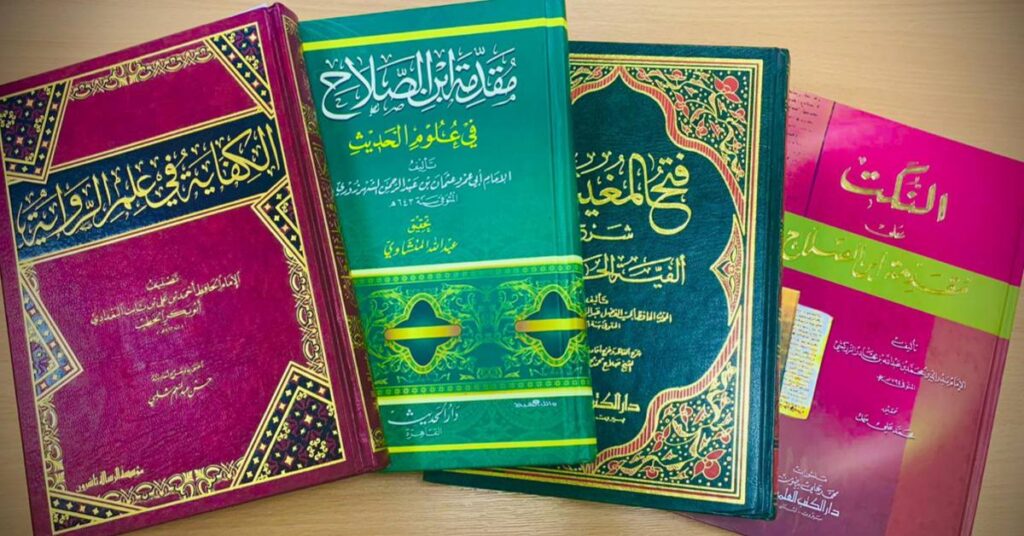Definition of Riwāyah al-Ḥadīth (Narration of Ḥadīth):
The early scholars did not formulate it, but it can be deduced from their usage. Perhaps the first to define al-Riwāyah was Imām Muḥammad ibn Ibrāhim ibn al-Akfānī (d. 749 AH), as reported by Imām al-Biqāʿī (d. 885AH) and Imām al-Suyūṭī (d. 911AH). Imām Ibn al-Akfānī described ʿIlm al-Riwāyah as ‘the science, which involves transmitting the sayings and actions of the Prophet ﷺ, their narration (riwāyah), ḍabṭ (scrutiny), and taḥrīr alfaẓ (accuracy in conveying right words when narrating).'[1]قال الإمام البقاعي رحمه الله: رأيت الإمام شمس الدين محمد بن إبراهيم بن ساعد الأنصاري المعروف بابن الأكفاني … المزيد
Imām Zakariyya al-Anṣārī (d. 926AH) adds whilst defining Ḥadīth generally, it is ‘what is attributed to the Prophet ﷺ, his companions or anyone else, in terms of words, actions, reports or descriptions’. The science of Ḥadīth narration (al-riwāyah) is used to refer to this process, which includes the transmission of all of these elements.[2]قال الإمام زكريا الأنصاري رحمه الله: ما أضيف إلى النبي ﷺ قيل: أو إلى صحابي، أو إلى من دونه – قولا، أو فعلا، … المزيد
It should be noted that Imām Ibn al-Akfānī did not mention the attributes and al-taqrīr (affirmation reports), nor did he address the narrations of the ṣaḥābah, the tābiʿīn, and those who came after them. Imām Zakariyya al-Anṣārī provided clarification on these aspects.
Therefore, the adopted definition of narration can be summarised as follows:
‘Al-Riwāyah is the transmission of what is attributed to the Prophet ﷺ, his ṣaḥābah or anyone else through one of the acceptable methods of taḥammul (transmission), with ḍabṭ (precision), and taḥrīr al-alfaẓ (accuracy in conveying right words when narrating).’
The main stages of Ḥadīth narration (al-Riwāyah)[3](التحرير الفريد لعوالي الأسانيد، دلر الفرفور، 11- 15) وقال الشاه ولي الله رحمه الله: اعلم أنه لم ينقطع حفظ … المزيد
Al-Riwāyah of Ḥadīth through history has undergone three main stages.
The first stage:
This stage begins from the era of the ṣaḥābah and ends around the end of the third century, as specified by Imām al-Dhahabī in the introduction of his book ‘Mīzān al-Iʿtidāl’.[4]قال الإمام الذهبي رحمه الله: الحد الفاصل بين المتقدم والمتأخر هو رأس سنة ثلثمائة. (ميزان الاعتدال، ت: البجاوي، … المزيد During this phase, the majority of transmitters conveyed Ḥadīth through the isnād (chain) of narrators to the Prophet ﷺ from their memory, while a few relied on their written collections.
This stage was distinguished by extreme accuracy, precision, and mastery. Allāh Almighty prepared for the Sunnah such a group of preservers who protected it from alteration and guarded it against its enemies, and distinguished the authentic from the weak.
The second stage:
This stage begins at the beginning of the fourth century and extends to the end of the ninth century approximately. In the previous stage, most of the prophetic traditions were documented by the ḥuffāẓ of Ḥadīth (experts of Ḥadīth), so the narration in this stage changed from transmission by memory to transmission of entire works, which the narrator would take from his teachers in one of the accepted methods of taḥammul (transmission), especially through qirā’ah (reading) and samāʿ (hearing). Nonetheless, the Ḥadīth scholars and students only resorted to seeking ijāzah (permission) to narrate any missed parts to supplement their narrations or to obtain a narration they did not hear before.
In this stage, the conditions for al-Riwāyah (narration) were relaxed because the purpose of narration after the completion of the documentation of Ḥadīth was only to preserve the chain of transmission that Allāh Almighty had bestowed upon this Ummah (nation).[5]قال الإمام ابن الصلاح رحمه الله: أعرض الناس في هذه الأعصار المتأخرة عن اعتبار مجموع ما بينا من الشروط في رواة … المزيد
However, narration remained a careful and precise practice, and did not undergo the extreme leniency that it experienced later on.
Shaykh ʿAbd al-Fattāḥ رحمه الله mentions in his work al-Isnād min al-Dīn:
‘The scholars would only give full consideration to the authenticity of book if its narrator is a reliable, just and trustworthy person who has either read it from its author or has a continuous chain (isnād) of transmission connecting its reading and receiving (talaqqī) from their teachers to the author.
As for a book that a scholar finds as wijādah (narrating unverified handwritten material newly discovered), which they have not heard from the author nor have they been given an authorisation (ijāzah), it is considered an al-khabar al-munqaṭiʿ (untraceable source) or al-mursal (missing link), as established by the scholars of Muṣṭalāḥ (Ḥadīth terminology).[6]قال الشيخ عبد الفتاح أبو غدة – رحمه الله: أنّ المتقدمين من علماء المسلمين، لا يعطوا الاعتبار التّام للكتاب … المزيد
Most of the early Ḥadīth scholars and jurists prohibited taking from such a source, while later scholars allowed it with strict conditions due to the difficulty of fulfilling the requirement of narration in later times. Those sources that can be traced back to their authors are considered reliable, while those that cannot be traced back to their authors are not relied upon by consensus. All of this is done to ensure that the transmission is authentic, the authentication is ensured, and to verify knowledge, its accuracy, history, and its passage to future generations.”
Consequently, the stringent conditions imposed on narrators transfered to stringent conditions in ensuring the authenticity of book editions with rigorous inspection, such as muqābalah al-nusakh where a student would compare and revise his edition to the edition of his shaykh through qirā’ah (reading) and samāʿ (hearing), and this practice continued to the author of the original work.
Hence, when reliable manuscripts were being used for recitals (maqra’ah), the scholars relaxed the requirements for narrators to include individuals aged five and above in the ṭībaq document (list of attendees who have samāʿ for the work). This is because the reliance in verifying the text of the narration was based on the edition that was read, not on the memory or specific qualifications of the narrators. Instead, it was based on the correct copies of the Ḥadīth books written by the scholars of Ḥadīth.
Therefore, the new modified requirements for the eligibility of the narrator was, one who is mature, sane Muslim without any outward signs of immorality, and with samāʿ (hearing) attendance being well documented by a trustworthy person, and the narration being in agreement with the original version heard from his shaykh.”[7]قال الإمام ابن الصلاح رحمه الله: وليكتف في أهلية الشيخ بكونه مسلما، بالغا، عاقلا، غير متظاهر بالفسق والسخف، … المزيد
The third stage:
This stage begins at the beginning of the tenth century approximately, as time passed the determination to acquire samāʿ (hearing) of Ḥadīth works weakened. The only works that remained in circulation were the well-known ones, such as the Saḥīḥayn, the four Sunan, al-Muwaṭṭa’, Musnad al-Dārimī, and Musnad al-Ḥumaydī. Only a few people excelled in samāʿ (hearing) and ismaʿ (narrating) other works. The practice of muqābalah al-nusakh and similar methods was reduced to revising later Ḥadīth commentaries and Ḥadīth dictionaries.
Since the beginning of this stage, precision, accuracy, and investigation have continued to decline. If we examine the athbāt of the scholars (works where chains are mentioned), we can observe extreme leniency and the weak methods of narration that early ḥuffāẓ of Ḥadīth (experts of Ḥadīth) would never have allowed.
Outcome:
The preceding stages suggest that the early ʿulamā’ predominantly relied on samāʿ (hearing) and qirā’ah (reading), as their main source of knowledge transmission, while the later scholars primarily obtained transmission through the process of acquiring ijāzah (authorisation).
As for the intermediate level, they had extensive samāʿ and many ijāzāt. In order to maintain the honour of samāʿ, the late scholars who were also hearers of Ḥadīth (musmiʿ), introduced two levels of recitation (iqrā’) in the books of narrations:
The first level is the mere reading of the books of Ḥadīth, without explanation of their meanings.
The second level is to explain what was needed in moderate explanation without prolonging it.
The first level of recitation was for the expert ʿulamā’ and students in this field, so that they can quickly hear the ḥadīth and its chain of narration, and then refer the rest of the research to the commentaries, as the correction of ḥadīth is done through commentaries and annotations. They give priority to the second level for beginners and intermediates, so that they can understand the important aspects of ḥadīth and benefit from it in their research.
This was transmitted by Shāh Walī Allāh al-Dihlawī in his book ‘Itḥāf al-Nabīh'[8]اعلم أن دراسة كتب الحديث عند علماء الحرمين على ثلاثة مناهج:الأول: منهج السرد وهو أن يقرأ الشيخ الـمُسْمِع أو … المزيد from the Ḥadīth scholars of the two holy cities in the 12th century, such as Aḥmad al-Nakhlī, Hasan al-ʿUjaymī, Aḥmad al-Qaṭṭān, Abū Ṭāhir al-Kurdī, and al-Tāj al-Qilʿī. He mentioned that they inherited these two levels from their predecessors.
This tradition continued in Yemen, Morocco and India, unbroken to this day. The people of Lower Yemen inherited it from the legacy of Imām Yaḥyā ibn ʿUmar al-Ahdal, the people of Morocco from the legacy of Imām ʿAbd al-Qādir ibn ʿAlī al-Fassī, and the people of India from the legacy of Imām Walī Allāh al-Dihlawī. Perhaps there are others with similar practices, but unforeseen circumstances have hindered the continuation of their academic institutions.
Taken from the fawā’id of our beloved teacher:
Shaykh Mohammed Daniel al-Muhājir al-Dimashqī;
Founder of Cordoba Academy.
www.cordobaacademy.com
الحاشية[+]
| ↑1 | قال الإمام البقاعي رحمه الله: رأيت الإمام شمس الدين محمد بن إبراهيم بن ساعد الأنصاري المعروف بابن الأكفاني الشافعي قال في كتابه “إرشاد القاصد” الذي تكلم فيه على أنواع العلوم، وتعاريفها، وما صنف فيها من محاسن الكتب: علم الحديث الخاص بالرواية: علم يشتمل على نقل أقوال النبي ﷺ، وأفعاله، وروايتها، وضبطها، وتحرير ألفاظها. (النكت الوفية بما في شرح الألفية للإمام البقاعي، ت: ماهر ياسين الفحل، 1/63)
قال الإمام السيوطي رحمه الله: قال ابن الأكفاني في كتاب إرشاد القاصد، الذي تكلم فيه على أنواع العلوم: علم الحديث الخاص بالرواية: علم يشتمل على نقل أقوال النبي ﷺ وأفعاله، وروايتها، وضبطها، وتحرير ألفاظها. (تدريب الراوي للإمام السيوطي، ت:طارق بن عوض الله، 1/37). |
|---|---|
| ↑2 | قال الإمام زكريا الأنصاري رحمه الله: ما أضيف إلى النبي ﷺ قيل: أو إلى صحابي، أو إلى من دونه – قولا، أو فعلا، أو تقريرا، أو صفة، ويعبر عن هذا بعلم الحديث رواية. (فتح الباقي بشرح ألفية العراقي للإمام زكريا الأنصاري، ت: عبد اللطيف هميم وماهر الفحل، 1/91). |
| ↑3 | (التحرير الفريد لعوالي الأسانيد، دلر الفرفور، 11- 15)
وقال الشاه ولي الله رحمه الله: اعلم أنه لم ينقطع حفظ الحديث والإتقان في معرفته إلى الطبقة التي أدركناها، إلا أنَّ له في هذه الأمة المرحومة أطوارًا مختلفة: ففي الصحابة والتابعين كانوا يحفظون الأحاديث عن ظهر قلب، وكان جـلّ اهتمامهم في تكرارها ومراعاتها. ولما جاء عصر التدوين والتأليف حفظوا الأحاديث بكتابتها، فكان اهتمامهم بتجويد كتابتها، وتصحيح الكتاب، وحفظه من البلل والحريق وغيرهما. |
| ↑4 | قال الإمام الذهبي رحمه الله: الحد الفاصل بين المتقدم والمتأخر هو رأس سنة ثلثمائة. (ميزان الاعتدال، ت: البجاوي، 1/4). |
| ↑5 | قال الإمام ابن الصلاح رحمه الله: أعرض الناس في هذه الأعصار المتأخرة عن اعتبار مجموع ما بينا من الشروط في رواة الحديث ومشايخه، فلم يتقيدوا بها في رواياتهم؛ لتعذر الوفاء بذلك على نحو ما تقدم، وكان عليه من تقدم. ووجه ذلك ما قدمناه في أول كتابنا هذا من كون المقصود آل آخرا إلى المحافظة على خصيصة هذه الأمة في الأسانيد والمحاذرة من انقطاع سلسلتها. (معرفة أنواع علوم الحديث مقدمة ابن الصلاح، ت: عتر،120). |
| ↑6 | قال الشيخ عبد الفتاح أبو غدة – رحمه الله: أنّ المتقدمين من علماء المسلمين، لا يعطوا الاعتبار التّام للكتاب إلّا إذا كان راويه الثقة الضابط العدل، قد قرأه على مؤلفه، أو كان لديه سند متّصل بقراءة الكتاب وتلقّيه من شيوخهم إلى مؤلفه. أما الكتاب الذي يجده العالمُ وجادةً، ولم يسمع من مؤلِّفه، ولا له منه إجازة، فهو من باب الخير المنقطع والمرسل، كما قرّره علماء المصطلح، وقد منع الأخذ منه معظم المحدثين والفقهاء من المتقدمين، وأجازه المتأخرون بشروط ضيّقة لتعذر شرط الرواية في الأعصار المتأخرة. وهذا منهم فيما يوثق بنسبته إلى مؤلّفه، أما ما لا يوثق بنسبته، فلا اعتداد به بالاتّفاق. وما هذا كلّه إلا ليكون النّقل صحيحا، والتوثّق تامًّا، ولتأخذ الكلمة العلمية ثبوتـها وصحتها، وضبطها وتاريـخها وانتقالـها إلى الأجيال الاحقة. (الإسناد من الدين، دار البشائر الإسلامية، 34). |
| ↑7 | قال الإمام ابن الصلاح رحمه الله: وليكتف في أهلية الشيخ بكونه مسلما، بالغا، عاقلا، غير متظاهر بالفسق والسخف، وفي ضبطه: بوجود سماعه مثبتا بخط غير متهم وبروايته من أصل موافق لأصل شيخه. وقد سبق إلى نحو ما ذكرناه الحافظ الفقيه أبو بكر البيهقي – رحمه الله – فإنه ذكر فيما روينا عنه توسع من توسع في السماع من بعض محدثي زمانه الذين لا يحفظون حديثهم، ولا يحسنون قراءته من كتبهم، ولا يعرفون ما يقرأ عليهم بعد أن تكون القراءة عليهم من أصل سماعهم. ووجه ذلك: بأن الأحاديث التي قد صحت أو وقفت بين الصحة والسقم قد دونت وكتبت في الجوامع التي جمعها أئمة الحديث، ولا يجوز أن يذهب شيء منها على جميعهم، وإن جاز أن يذهب على بعضهم لضمان صاحب الشريعة حفظها.قال: فمن جاء اليوم بحديث لا يوجد عند جميعهم لم يقبل منه، ومن جاء بحديث معروف عندهم، فالذي يرويه لا ينفرد بروايته، والحجة قائمة بحديثه برواية غيره، والقصد من روايته والسماع منه، أن يصير الحديث مسلسلا بـ حدثنا وأخبرنا، وتبقى هذه الكرامة التي خصت بها هذه الأمة، شرفا لنبينا المصطفى صلى الله عليه وعلى آله وسلم. (معرفة أنواع علوم الحديث مقدمة ابن الصلاح، ت: عتر،121). |
| ↑8 | اعلم أن دراسة كتب الحديث عند علماء الحرمين على ثلاثة مناهج: الأول: منهج السرد وهو أن يقرأ الشيخ الـمُسْمِع أو القارئ الكتاب بدون تعرّض للمباحث اللغوية والفقهية وأسماء الرجال وغيرها. الثاني: منهج البحث والتحليل، وهو أن يتوقف بعد قراءة حديث عند غريبه وتراكيبه العويصة، والاسم النادر من أسماء رجال إسناده، وما يرد عليه من السؤال الظاهر في المسألة المنصوص عليها، ويـحلّ هذه الأمور بكلام متوسط، ثم ينتقل إلى الحديث التالي على هذا القياس. الثالث: منهج الإمعان والتعمق، وهو أن يتكلم كثيراً على كل كلمة من الحديث بـما لها وما عليها وما يتعلق بها، فمثلاً في شرح الغريب ومشكل الإعراب يذكر الشواهد من الشعر، ويستطرد إلى بيان المادة اللغوية واشتقاقاتـها وأماكن استعمالها، وفي أسماء الرجال يذكر تراجمهم وأحوالهم، ويـُخرّج المسائل الفقهية على المسألة المنصوص عليها، ويحكي حكايات غريبة وقصصا عجيبة بأدنى مناسبة. وقد رأيتُ علماء الحرمين الشريفين على هذه المناهج الثلاثة، فكان اختيار الشيخ حسن العجيمي وأحمد القطان، والشيخ أبي طاهر وغيرهم، منهج السَّرْد بالنسبة للخواص المتبحرين، ليقوموا بسماع الحديث وتصحيح متنه وإسناده بسرعة، وكانوا يـحيلون إلى شروح الكتب للمباحث الأخرى، لأنَّ مـدار ضبط الحديث اليـوم على تتبع هذه الشروح. أما بالنسبة للمبتدئين والمتوسطين فكانوا يـختارون لهم منهج البحث، ليحيطوا بما يجب معرفته في علم الحديث ويستفيدوا منه، وكانوا في هذه الحالة يضعون أمامهم غالبًا شرحًا من الشروح يراجعونه في أثناء البحث. أما المنهج الثالث فهو منهج وكان القصد منه إظهار العلم والفضل أو غيرهما، لا الرواية وتحصيل العلم، والله أعلم. (اتحاف النبيه، تعريب:محمد عزير شمس، 154-155) والغاية من السماع والرواية 9-10. |




